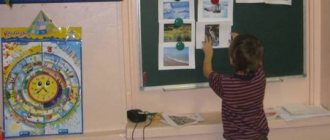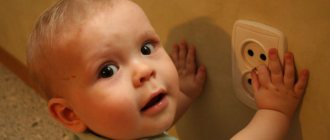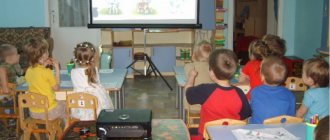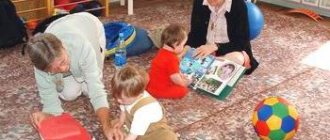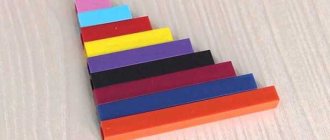Summary of educational activities for cognitive development with children of the preparatory group “Types of transport”
GCD in the preparatory group of a preschool educational institution.
Preparatory group Program objectives: 1. Develop knowledge about transport, its types 2. Develop children’s ability to distinguish between land, air and water transport.
3. Develop mental activity and attention. 5. Cultivate cognitive interest Progress:
Organizational moment. Guys, before we start our lesson, I want to invite you to solve riddles . 1. This horse does not eat oats, instead of legs there are two wheels. Sit on horseback and race on it, but it’s better to steer. (Bicycle) 2. A wonderful long house, There are many passengers in it. Wears shoes made of rubber And eats gasoline... (Bus) 3. Doesn't fly, but buzzes, A beetle runs down the street. And two brilliant lights burn in the beetle’s eyes. (Car) 4. Amazing carriage! Judge for yourself: The rails are in the air, and he holds them with his hands. (Trolleybus) 5. Well, my friend, guess, Only this is not a tram. A line of huts quickly rushes into the distance along the rails. (Train) 6. The giant lifts a lot of cargo to the clouds. Where he stands, then a new house grows. (Crane) 7. Without accelerating, it takes off high, Reminds me of a dragonfly, Sets off on a high-speed flight... (Helicopter) 8. Here is a steel bird, It strives for the skies, And its pilot leads it. What kind of bird? (Airplane) Well done, you guessed all the riddles. Now call it all in one word / Transport
Correctly, the topic of our lesson today is “Transport”
Conversation “Types of Transport” Transport can be different not only in appearance, but also in purpose, and also in the place of movement. What kind of transport do you think is called air transport? / Children's answers
Air transport is transport that moves through the air.
Name air transport / Plane, helicopter, parachute, airship, airplane, hot air balloon.
Air transport is the fastest mode of transport.
Air transport is mainly used for passenger transportation over distances of over a thousand kilometers. Freight transport is also carried out, but their share is very low. Most often, perishable products and especially valuable cargo, as well as mail, are transported by air. What kind of transport is called water transport? / Children's answers
Water transport is transport that moves on water. Name water transport. / Submarine, ship, kayak, boat, raft

Water transport is vital where land transportation is impossible: between continents, islands, and in poorly developed areas. The speed of water transport is relatively low, so at present it is almost never used for passenger transport. What kind of transport is called ground transport? / Children's answers
Ground transport is transport that moves on the ground. Name ground transport / Children's answers Ground transport is divided into different types of transport: trackless, road, railway
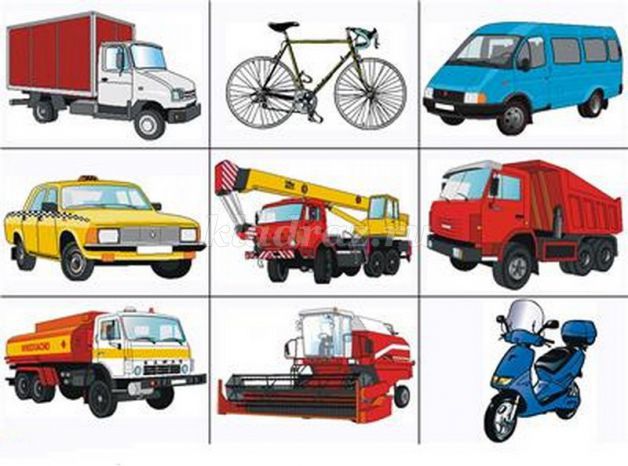
This is the most common type of transport. They use ground transport for various needs. For example, a passenger car for traveling short distances. Trains, trams, trolleybuses, electric trains are needed to transport passengers and are called public transport. Various dump trucks, trucks and Kamaz trucks are called freight transport, as they are used to transport goods. Motorcycles and bicycles are called two-wheelers and are used to travel around the area. There is also special transport, it is used by people of different professions. Such vehicles include an ambulance, a police car, a tractor, a fire truck, a garbage truck, a combine harvester, etc.
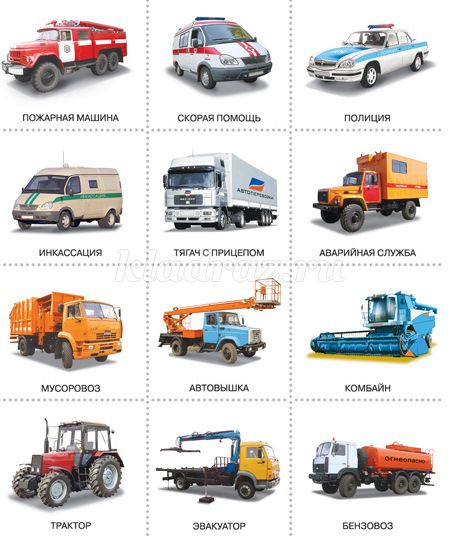
Now let’s see how well you can distinguish between air, water, and land transport. Didactic game "Fourth odd"
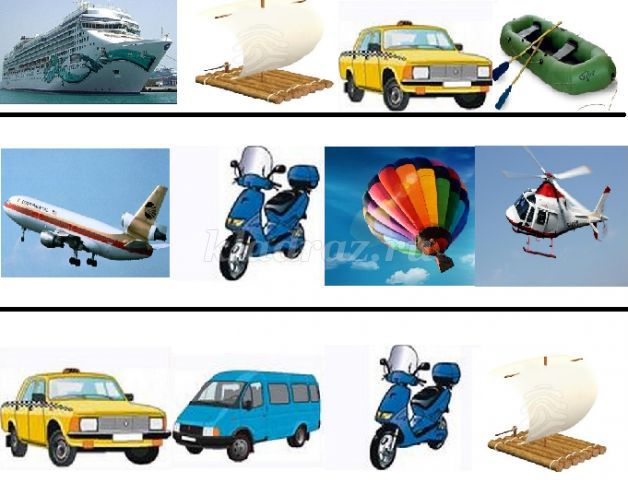
Great! Well done! Now I want to give you some homework. The teacher distributes road signs to the children.
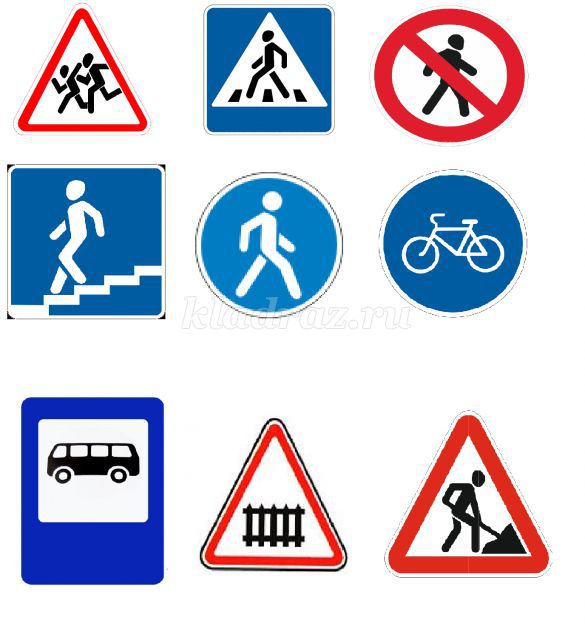
For your next lesson, be prepared to talk about these road signs. The topic of our next lesson is “Road Safety”.
We recommend watching:
Summary of educational activities for cognitive development in the preparatory group "Journey to the North" Summary of educational activities in the preparatory group on the topic "Reservoirs" Summary of educational activities for cognition in the middle group on the topic "Transport" Summary of educational activities for speech development in the senior group on the topic: Transport
Similar articles:
Summary of a lesson in the preparatory group on the topic: Rules of conduct in kindergarten
Life safety lesson “Rules of safe behavior on water.” Preparatory group
Abstract of GCD in mathematics in the preparatory group. Counting to 11 and 12
Summary of mathematics lessons in the preparatory group. Number composition
Summary of mathematics lessons in the preparatory group. Adding and subtracting numbers
Summary of a lesson on speech development in the preparatory group "Transport"
Tatyana Golubeva
Summary of a lesson on speech development in the preparatory group "Transport"
1. Expand and consolidate ideas about transport based on systematization and generalization of previously formed ideas. Clarify, expand and activate vocabulary on the topic;
2. Continue learning to compose complex sentences and form complex words. Make sentences from the words given in the initial position. Train in writing descriptive stories according to plan. Continue to teach children to conduct a sound analysis of a word, learn to calculate word stress and determine its place in a word.
2. Develop coherent speech , visual attention and perception, memory, thinking, speech hearing , coordination of speech with movement;
3. Develop skills of cooperation, mutual understanding, and goodwill.
Methods and techniques: visualization, didactic game, literary expression, conversation.
Equipment: pictures on the topic “ Transport ”
, sky, road, sea, word sound analysis table.
Preliminary work: general conversation about transport . Learning the exercise “On the Highway”
, finger game
"
Transport " , riddles and tongue twisters about
transport .
Calendar plan on the topic “Transport” for the week
Topic: "Transport"
Monday.
Morning.
1. Conversation on the topic. “We’ve arrived, we’re going, we’re going.” Target. Clarify with children the purpose of transport, types of transport and its characteristics in the present, past and future tense.
2. D/I “Choose the word”, “One is many”, “The fourth is odd”, “Say the opposite” Purpose. Exercise children in selecting adjectives.
3. Did. ex. “Why is this and not otherwise?” Goal: to develop the ability to prove the correctness of one’s own judgments, to defend one’s point of view.
4. Training game “Depict the mood” Goal. To develop in children the ability to manage their emotions in conflict situations, to continue to introduce them to ways of resolving conflicts and relieving tension. Form a conscious attitude towards social norms of behavior.
5. Canteen duty. Target. Develop the ability to engage in work relationships with adults. Foster independence, form ideas about rational ways to carry out feasible tasks.
6. KGN. Strengthen the ability to eat food carefully, silently, maintaining correct posture at the table.
GCD 1. Speech therapy
2. H.E.R. Modeling
“Such different transport”
Software tasks:
develop the ability to compare different types of transport, find similarities and differences in accordance with their type, consolidate children’s skills in making plasticine mosaics, cultivate cognitive interest, develop the ability to compare different types of transport, find similarities and differences in accordance with their type; the ability to answer questions, draw conclusions, imitate different types of transport, encourage children to be independent in the game, evoke in children an emotional, positive response to game actions, and create friendly relationships between children.
Material:
modeling boards, plasticine of different colors, stacks, pictures of transport.
Dictionary:
hardworking, cozy, helpful.
Methodical techniques:
org. moment - greeting, conversation about transport, riddles, physical exercises, explanation of modeling techniques, independent and other. work, result.
3. H.E.R. Musical
Walk
1. Bird watching. Notice that birds are coming to us again. Which birds are migratory and which are wintering? Target. To consolidate children's knowledge about birds: name, body parts, nutrition. Remember that there are migratory and wintering birds.
2. Work on the site. Have the area cleared of debris. Target. Develop a desire to work, cultivate independence and responsibility.
3. P/games “Cars”, “Transport”, “Free Space”. Goal: to practice sprinting, jumping, and the ability to perform actions on a signal.
4. Individual work “Don’t lose the ball.” Goal: to consolidate the ability to perform the exercise consistently.
5. Research activity: comparison of different types of transport (find similarities and differences)
2 half day.
1. Reading I. Ivin “Cars of our street.” Target. Continue to introduce children to literature on the topic of transport, instill an interest in literary expression.
2. Constructive activity. Origami. "Boat". Target. Help children master several methods of paper construction. Teach children to work according to a diagram that shows the sequence of work. Develop creativity, intellectual initiative, and the desire to find new solutions based on already familiar methods. Cultivate the ability to complete the work started, independence.
Walk
1. Work on the site. Restoring order in the area. Instruct them to sweep the stairs and path leading to the site. Target. Instill responsibility in fulfilling this assignment and conscientiousness.
2. P/games “Airfield”, “Pilot” /running/, “Pathfinders” /space orientation/.
3. Ind. according to physical examination. practice throwing a medicine ball with both hands from behind the head, to promote the development of strength abilities.
Tuesday.
Morning.
1. Conversation on the topic “Water transport”. Target. Ask children who have relatives who work in water transport, what they told you about their work, and what they like best.
2. D/game “Every picture has its place”, “Yes - no”, “Cut pictures”, “Confusion” (all types of transport: sort by type). C. develop attention and thinking.
3. Listening to songs about rivers and seas. Target. Teach children to identify means of musical expression that create an image, and to characterize them.
4. ISO. Invite children to draw an image of the character they heard, randomly select the color and technique of creating the image.
5. S/r game “Journey”. Target. Develop imagination, thinking, friendships.
GCD 1. Speech therapy
2.
P.R.
FEMP " Year"
Program content:
continue to learn to independently compose and solve problems involving addition and subtraction within 10, practice the ability to navigate on a sheet of paper in a square, consolidate the concepts of “year”, “season”, develop the ability to combine parts of a set, compare the whole and its parts based on counting , improve the ability to see the shapes of familiar geometric figures in surrounding objects.
Material:
cards with numbers and arithmetic signs, a ball, a “Seasons” clock, cards with schematic images of men in various poses, a tambourine, a sample pattern on a checkered board, cards with numbers and arithmetic signs, checkered notebooks, pencils.
Dictionary:
model, combine, add, year, season.
Methodical techniques:
org. moment - game “Name objects of the same shape”, exercise “Let’s make a problem”, d/i “All year round”, physical exercise “Dancing men”, exercise “Putting bricks in a row”, d/i “How many together?”, result.
3.
F.R.
Physical education No. 51. II
half.
day H.E.R. Drawing “Transport of our city”
Program content:
expand children's knowledge about surrounding transport. develop creativity; consolidate the ability to draw rectangular objects, more accurately convey proportions and characteristic details, create images of literary works in the drawing; practice drawing and filling in drawings with pencils.
Handout:
colored pencils, wax crayons, A4 album sheets,
Vocabulary work:
gasoline, off-road, tram, string.
Methodical techniques:
org. moment - the game “Transport of our city”, riddles about transport, looking at pictures, the game “Question and answer”, the game “What is in the beginning and then”, physical exercises,
consideration of diagrams of sequential drawing of several types of transport, practical work, result.
Walk
1. Monitoring the operation of the traffic light. Goal: to consolidate knowledge that traffic lights control the complex movement of vehicles and pedestrians.
2. Outdoor game “Brave guys”. Goals: practice fast running; develop dexterity.
3. “One - two”, “Pass silently.” Goals: learn to walk clearly, rhythmically, with good posture and coordination of movements; use walking as a means of developing endurance.
4. Exercise “Walk on a log.” Goal: to exercise the ability to maintain stable balance, to improve walking technique.
5. Situational conversation “Being an exemplary pedestrian is allowed (reinforcement of traffic rules)
6. Game “Make no mistake.” Develop quick thinking, consolidate children's knowledge of what they do at different times of the day.
7. Ind. Job. "Hit the hoop." Goal: practice throwing at a target.
2 half day.
1. Dramatization of the fable “The Crow and the Fox.” Basics of acting: learn to portray the emotional state of animals using expressive movements and intonation.
2. D/game “What is missing” (with road signs). Goal: to develop visual memory and attention.
3. Role-playing games: “Land transport.” Target. To consolidate children's knowledge of the rules on the roads in games.
4. Mathematical games and puzzles: “Labyrinth”, “Crosswords”, “Rebuses”, “In the Forest School” /quantity and counting/. Target. Develop logical thinking and imagination.
Walk
1. Observation of the dog. Foster a love for animals, remind children that they should not touch unknown animals for health reasons.
2. Ind/r. “Snake” trains children to jog along a winding path /orientation in space/.
3. Free communication “Why know the rules of the road”, “Don’t cross the street without paying attention to the traffic light.” Target. Reinforcement of rules on the roads.
4. P/ games “The Third Wheel”, “Burn, Burn Clear”, “Burners” /running/.
5. Physical entertainment. "Spring drops." Target. To teach how to act on a signal, to help improve movements in children’s active activities.
6. Play activities. S/r game "Dining Room"; "Beauty saloon". C. enrich the content of games, consolidate the ability to independently organize games.
Wednesday
Morning.
1. D/game “Find out by description.” Goal: develop the ability to work with models, determine the type of transport based on essential features
2. Riddles about transport. Target. To intensify the mental activity of children in the process of observing the surrounding reality and the development of speech. Give a figurative idea of transport, teach comparison and comparison.
3. S/r game “Car Exhibition”. C. Strengthen the ability to independently organize games, develop a plot, and perform role-playing actions.
4. Construction games. Buildings according to plan. Target. Encourage children's creative initiative and design abilities.
GCD 1. Speech therapy
2. S.K.R. life safety fundamentals
"In city transport"
Software tasks:
form ideas about transport, clarify knowledge about the rules of behavior in transport, develop children’s cognitive interest, and cultivate a culture of behavior in public transport.
Equipment:
presentation “In urban transport”, felt-tip pens, paper, scissors and glue
Vocabulary work:
tundra, desert, sledges, elderly.
Methodical techniques:
org. moment - riddles about the first transportation, watching a presentation, talking about types of transport, formulating the rules of cultural behavior in transport, physical exercises, the game “Good - Bad”, drawing “I am in transport”, the result.
3. H.E.R. Musical
Walk
1. Observation of the work of a janitor. What are the responsibilities of a janitor? C. Instill work skills.
2. Ind/r. Practice jumping, develop jumping skills and coordination.
3. P/games “Wolf in the Moat” /jumping/, “Forbidden Movement”. Target. Develop orientation in space, enrich motor experience.
4. Experience. Place an ice cube in two buckets, cover one bucket with a cap. Where will the ice melt first? Target. Develop curiosity and interest in experiments.
2 half day.
1. Reading the work of G. Tsyferov “Locomotive from Romashkov”. Improving retelling skills.
2. D/game “On earth and underground, in the sky and at sea.” Purpose: to exercise in the classification of transport by type, according to characteristic features
3. D/i “Collect a picture.” Target. Exercise children in recognizing and naming individual parts of transport. Develop imagination, fine motor skills, memory, patience.
Walk
1. Surveillance of a passenger car. Objectives: continue to distinguish cars by their purpose, compare with other modes of transport; develop observation skills.
2. Labor activity. Clearing the area of debris. Goal: to cultivate diligence and the desire to work together.
3. Outdoor games: “Snow Queen”, “Dodgeball”. Goal: to develop agility, running speed, attention.
4. Individual work. Practice jumping up from a place. Goal: develop the ability to concentrate effort, combine strength with speed.
Thursday
Morning.
1. Conversation on the topic “Who controls the transport?” Goal: systematize knowledge about the professions of people in transport
2. Staging of a poem by B. Zakhoder. "Chauffeur". C. Teach children to act out short poems, imitating the content.
3. Work order. Cut napkins and prepare for breakfast. Target. Foster the need to work and help adults.
4. Fine art offer coloring pages on the theme “Transport”. C. develop fine motor skills of the fingers.
GCD 1. Speech therapy
2.ETC. FEMP
“Preparation and solution of problems”
Program content :
continue to learn how to independently compose and solve problems involving addition and subtraction within 10, consolidate the ability to sequentially name the days of the week, develop the ability to model spatial relationships between objects on the plan, and develop spatial perception of shape.
Material:
ball, sheets of paper (1/2 sheet, whole sheet), pencils, cards with numbers and arithmetic signs, workbooks.
Dictionary:
the day after tomorrow, the day before yesterday.
Methodical techniques:
org. moment - exercise “Name the day of the week”, exercise “Let’s create a problem”, exercise “Let’s help the birds move into houses”, exercise “Formland”, physical exercise, work in notebooks, summary.
3. H.E.R. Drawing
"Cars"
Software tasks:
develop the ability to convey in a drawing the shape and structure of a passenger car: elongated, with a smooth transition from part to part, the ability to use a simple pencil to create an auxiliary drawing, consolidate the ability to hatch according to given instructions: from left to right, in a circle; correct pronunciation of noun endings;
the ability to form adjectives from nouns; the ability to coordinate text with movement, highlighting stressed words in the text with voice and gesture; develop mental operations, attention, thinking, fine motor skills, auditory perception; the ability to objectively evaluate one’s own work and the work of comrades.
Vocabulary work:
transport, car, pier, station, airfield, cargo, passenger, passenger, transport, moor, land, hatch, right, left.
Material:
ball, tape recorder, sheet of Whatman paper, felt-tip pen, set of colored pencils, simple pencil, sheet of white paper.
Methodical techniques: org. moment “Name the transport”, listening to a recording of the “sounds of transport” on a tape recorder, discussing drawing methods, physical exercise: “The buses were running”, independent and ind. work, result.
Physical education in games on a walk No. 26
Walk
1. Observation of coniferous trees. How are they similar and how are they different from deciduous trees? Consider the trunk, branches, needles, trees. Teach children to notice the beauty of nature and its uniqueness.
2. Labor. Clear the area of dry branches. Tag the most active children.
3. Games with external material at the request of the children. C. Strengthen behavioral skills during games, respect the interests of other children.
4. Sports game “Towns”. Improve your throwing technique.
5. Outdoor games: “Dodgeball”. Target. Develop organization skills while playing. “Throwing at the target” (throwing technique), “Serpentine”. Goals: to learn to perform actions on a signal, to work smoothly with your hands, to run in a certain direction; develop speed and agility.
2 half day
1. D/game “Who’s on what.” Goal: to develop ingenuity and imagination in determining what a particular fairy-tale character can move on
2. Reading the story by M. Ilyin and E. Segal “Cars on our street.” Goal: expand children’s knowledge about special types of ground urban transport
3. D/games “Explain the word”, “Correct the sentence”, “Guess the riddles and explain what helped you solve them.” Target. Strengthen children's knowledge about transport, develop and activate children's speech.
4. S/r game “Airfield” with building materials. Target. Fix the name of the details in time to play around with the buildings. Teach children before the game starts, coordinate actions, distribute roles, prepare the necessary equipment. Develop the ability to negotiate and share building materials
5. Outdoor games “Ring throwing”. Target. development of eye and throwing technique
Walk
1. Labor. Clearing the veranda of debris. Nurturing hard work
2. Himself. play activity. Instill a friendly attitude towards children during games, respect the interests of others.
3. Ind/r. improve your throwing technique.
4. P/games. games “Ride the car through the gate” /endurance/, “I’ll catch up”, “Sharp shooter” /throwing at the target/.
Friday
Morning.
1. Duty in a corner of nature. Target. Strengthen the ability to carry out various tasks related to caring for plants in a corner of nature; perform the duties of a duty officer in a corner of nature
2. D/games. “What flowers are in the group?”, “Show the flower”, “Describe the flower”, “Compare the plants”), “Live and artificial flowers”. C. consolidate knowledge about indoor plants
3. Game “How does day and night change?” (The earth rotates around its axis; when the earth is on the sunny side, it is day on Earth, and when it is in the shadow, it is night on Earth.
4. Creative games. “Explainers”, “Guessers”, “Rationales”. Target. Exercise children in guessing objects based on children's statements. Learn to ask leading questions, reason, and draw conclusions. Expand children's horizons, activate their vocabulary.
5. S/r game “Car Park”. Goal: continue to introduce children to professions, clarify what their work is?
6. Fine art offer coloring pages on the theme “Transport”. C. develop fine motor skills of the fingers.
GCD 1. Speech therapy
2.H.E.R. Application
"City transport on our street"
Software tasks:
create conditions for generalizing children’s knowledge about urban transport, continue to teach children to work with scissors, cut circles from a square, cutting off corners, teach how to complement the collective composition “City Street”, develop auditory attention, logical thinking, attention, expand and activate children’s vocabulary, cultivate independence, accuracy, and cooperation skills.
Materials and equipment:
“Our City” layout, pictures of urban transport, traffic light layout, “bus stop” and “pedestrian crossing” road signs, bus layout, steering wheel, conductor’s bag, travel tickets, composition from Whatman paper with a schematic image of a road with crossroads, picture diagrams for applique images of urban transport, colored paper, scissors, glue, glue brushes, oilcloths, napkins.
Vocabulary work:
city, passenger, conductor.
Methodical techniques:
org. moment - riddles about transport, the game “The Fourth Wheel”, the game “Ride on the Bus”, the game “You can - you can’t”, physical exercises, showing the method of action, ind. work, collective work “Urban transport on our street”, reflection.
3. P.R. Ecology
"Transport"
Software tasks:
improve and generalize knowledge about transport and traffic rules, consolidate knowledge about types of transport, the names of vehicles, the actions they perform, knowledge of traffic lights and the meaning of its signals; develop speech breathing; improve coherent speech skills; develop gross and fine motor skills; develop dexterity, reaction speed, coordination of movements, spatial concepts; develop expressiveness of speech and expressiveness of movements; develop logical thinking, attention, memory, imagination, cultivate cognitive interest in different types of transport; cultivate a sense of responsibility on the road; cultivate discipline and perseverance; develop the ability to work and play in a team.
Vocabulary work:
ground, underground, water, air, special purpose,
Material:
presentation on the topic “Transport”,
Methodical techniques:
org. the moment “What did you drive to kindergarten?”, a conversation about types of transport, watching a presentation, an exercise for coordinating speech with the movement “We’re going, we’re going by car...”, d/i “Who drives the transport”, low mobility game “Traffic Light”, outcome of the lesson, assessment of children’s activities.
II
half.
day F.R. Physical education No. 52 Walk
1. Observation of the drop. Target. To consolidate children's knowledge about changes in water depending on temperature; Teach research activities.
2. Work on the site. Target. Teach children to work together and help each other.
3. P/games “Tag”, “Wind” /running/, “Don’t get your feet wet” /jumping/.
4. Individual work: Walking on a slide; jumping from a place on two legs (energetic push-off and correct landing). Goal: to develop coordination of movement and balance.
5. S/r game “Souvenir shop”. C. Nurturing friendly relationships.
2nd
half of the day
1. Reading a work of fiction by N. Nosov “How Dunno rode in a carbonated car.” Goal: to continue to introduce children to the works of N. Nosov. Continue to teach to distinguish the genre features of a fairy tale, to comprehend the content of what is read. Form an evaluative attitude towards the heroes of the fairy tale. Give children a joyful mood from meeting their favorite characters.
2. D/I “Guess what the person’s profession is.” Target. reinforcement about tools.
3. D/ games: “Road signs”. Target. Continue to familiarize children with road signs
4. Game “Put the picture in the right place” (separation of water and air modes of transport)
Walk
1. Observation of the kidneys. Goal: to promote the development of environmental thinking and erudition.
2. Individual work on PHYS: walking on a slide; jumping from a place on two legs (energetic push-off and correct landing). Goal: develop a sense of balance.
3. Construction of a “Motorcycle”. Pay attention to the relationships between children and ways out of conflict situations.
4. P/game: “Gawkers.” Target. To foster logical thinking and the development of volitional (voluntary) attention.
